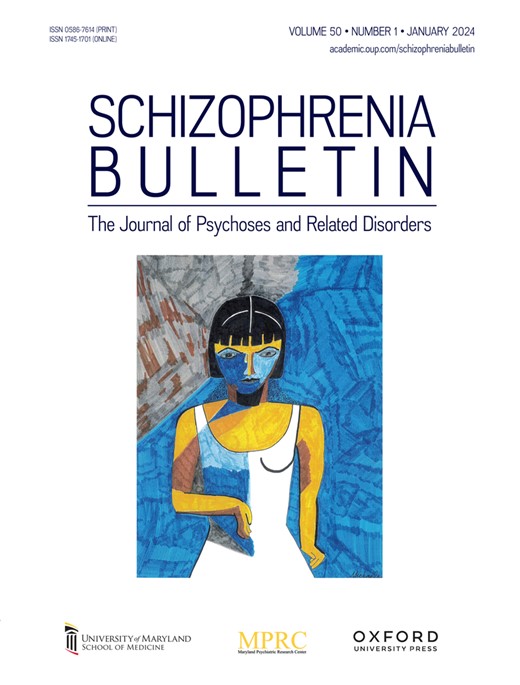akap11缺失小鼠中与精神分裂症相关的突触功能障碍和异常感觉运动门控
IF 5.3
1区 医学
Q1 PSYCHIATRY
引用次数: 0
摘要
背景与假设大规模全外显子组测序(WES)分析表明,AKAP11基因中罕见的蛋白质截断变异(PTVs)与精神分裂症风险有关。先前的研究报道了Akap11突变小鼠脑电图特征和突触蛋白质组的改变。我们假设在精神分裂症的发病机制中,突触功能障碍导致AKAP11缺失。我们制造了一只Akap11基因敲除小鼠,并采用一系列行为评估、神经元稀疏标记测定、电子显微镜和免疫沉淀质谱(IP-MS)来阐明Akap11对精神分裂症相关表型的影响。我们的行为范式评估显示,与野生型小鼠相比,Akap11缺陷小鼠表现出脉冲前抑制和焦虑样行为受损。神经元稀疏标记实验显示,Akap11缺失小鼠的总棘和细棘密度显著降低,电镜超微结构分析显示,抑制Akap11后突触发生明显改变,包括典型突触密度、突触囊泡密度和突触后密度(PSD)长度降低。IP-MS鉴定出222个高信度的Akap11相互作用蛋白,包括突触相关蛋白(如Exoc4、Ncam1、Picalm、Vapb)和肌动蛋白相关蛋白(Actb、Diaph1),富集分析进一步表明,Akap11可能参与RNA剪接、细胞外基质组织、轴突引导、nmda受体后激活事件、GPER1信号传导和PKA激活途径。总之,这些发现描述了Akap11缺陷小鼠的突触和行为表型,揭示了罕见PTVs在精神分裂症中作用的潜在机制,并证实了Akap11作为这种疾病的风险基因的重要性。本文章由计算机程序翻译,如有差异,请以英文原文为准。
Schizophrenia-Related Synaptic Dysfunction and Abnormal Sensorimotor Gating in Akap11-Deficient Mice
Background and Hypothesis Large-scale whole exome sequencing (WES) analyses have implicated rare protein-truncating variants (PTVs) in the AKAP11 gene contributing to schizophrenia risk. Previous studies reported alterations of EEG characteristics and synaptic proteome in Akap11 mutant mice. We hypothesize that synaptic dysfunction contributes to AKAP11 deficiency in the pathogenesis of schizophrenia. Study Design We generated an Akap11 knockout mouse and employed a series of behavioral evaluations, neuronal sparse labeling assays, electron microscopy, and immunoprecipitation mass spectrometry (IP-MS) to elucidate the impacts of Akap11 on schizophrenia-relevant phenotypes. Study Results Our behavioral paradigm evaluations revealed that Akap11 deficient mice exhibited impaired prepulse inhibition and anxiety-like behaviors compared with their wild-type littermates. Neuronal sparse labeling assays indicated a significant reduction in the density of total and thin spines in Akap11 deficient mice, and ultrastructural analysis via electron microscopy disclosed marked alterations in synaptogenesis after suppressing Akap11, including the reduced density of typical synapses, synaptic vesicle density, and postsynaptic density (PSD) length. IP-MS identified 222 high-confidence interaction proteins of Akap11, encompassing synapses-related proteins (eg, Exoc4, Ncam1, Picalm, Vapb) and actin-related proteins (Actb, Diaph1), and enrichment analyses further showed that Akap11 may contribute to RNA splicing, extracellular matrix organization, axon guidance, post-NMDA receptor activation events, GPER1 signaling and PKA activation pathways. Conclusions Together, these findings delineated the synaptic and behavioral phenotypes in Akap11 deficient mice, shedding light on the potential mechanisms underlying the role of rare PTVs in schizophrenia and substantiating the significance of AKAP11 as a risk gene for this illness.
求助全文
通过发布文献求助,成功后即可免费获取论文全文。
去求助
来源期刊

Schizophrenia Bulletin
医学-精神病学
CiteScore
11.40
自引率
6.10%
发文量
163
审稿时长
4-8 weeks
期刊介绍:
Schizophrenia Bulletin seeks to review recent developments and empirically based hypotheses regarding the etiology and treatment of schizophrenia. We view the field as broad and deep, and will publish new knowledge ranging from the molecular basis to social and cultural factors. We will give new emphasis to translational reports which simultaneously highlight basic neurobiological mechanisms and clinical manifestations. Some of the Bulletin content is invited as special features or manuscripts organized as a theme by special guest editors. Most pages of the Bulletin are devoted to unsolicited manuscripts of high quality that report original data or where we can provide a special venue for a major study or workshop report. Supplement issues are sometimes provided for manuscripts reporting from a recent conference.
 求助内容:
求助内容: 应助结果提醒方式:
应助结果提醒方式:


